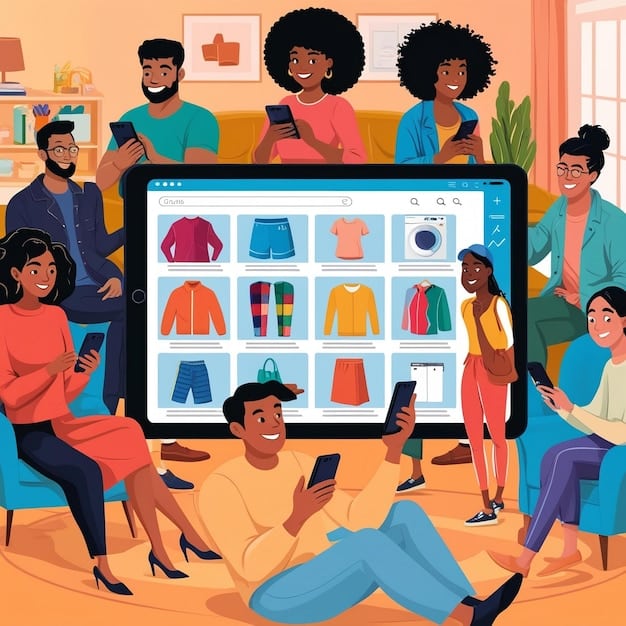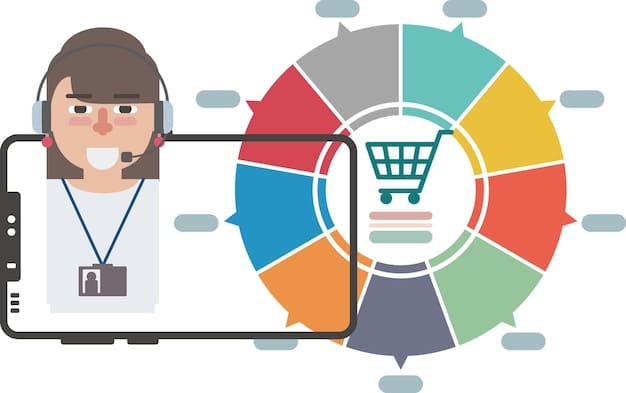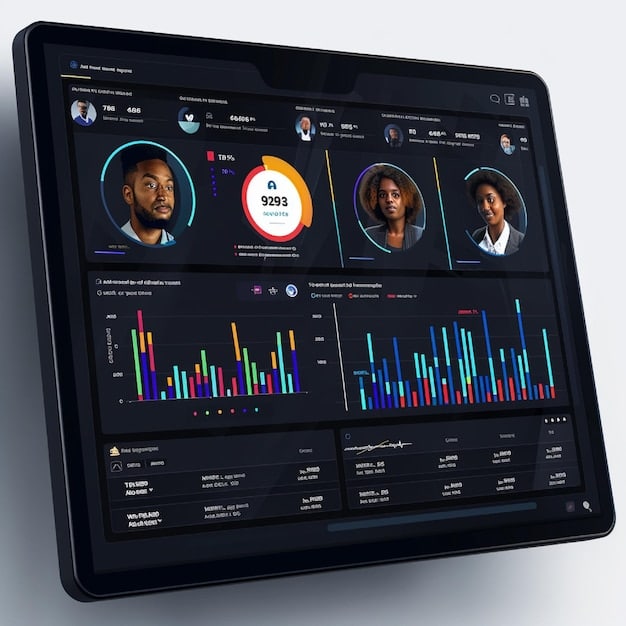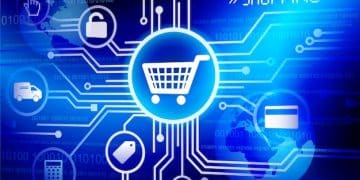E-commerce Customer Segmentation: Targeting the Right Customers in 2025

E-commerce Customer Segmentation: Targeting the Right Customers with the Right Message in 2025 involves dividing your customer base into groups with similar characteristics. This allows for more personalized and effective marketing strategies, enhancing customer experience and maximizing ROI.
In the ever-evolving landscape of e-commerce, understanding your customers is more critical than ever. That’s where E-commerce Customer Segmentation: Targeting the Right Customers with the Right Message in 2025 comes into play. It’s not just about knowing who your customers are, but understanding what they want, how they behave, and what motivates them to make a purchase.
Get ready to dive deep into the future of e-commerce marketing and discover how to leverage customer segmentation to create impactful strategies that will resonate with your audience and drive sales.
Understanding E-commerce Customer Segmentation
Customer segmentation is the process of diving customer base into distinct groups based on shared characteristics. This enables e-commerce businesses to tailor their marketing efforts and product offerings to each segment, resulting in increased customer satisfaction and higher conversion rates. But why is E-commerce Customer Segmentation: Targeting the Right Customers with the Right Message in 2025 so important?
Benefits of Customer Segmentation
Segmenting your e-commerce audience offers numerous benefits, from enhanced personalization to improved marketing ROI. Here are some key advantages:
- Enhanced Personalization: By understanding the specific needs and preferences of each segment, you can create personalized experiences.
- Improved Marketing ROI: Targeted campaigns are more effective, leading to higher conversion rates and better marketing ROI.
- Increased Customer Loyalty: Personalized experiences foster stronger relationships and increase customer loyalty.
- Better Product Development: Understanding customer needs helps in developing products that meet market demand.
Effective customer segmentation also provides valuable insights into customer behavior, buying patterns, and preferences. These insights can be used to optimize your marketing strategy, improve customer service, and enhance overall business performance. By focusing on E-commerce Customer Segmentation: Targeting the Right Customers with the Right Message in 2025, businesses can stay ahead of the competition and drive growth.

Key Segmentation Strategies for 2025
As we approach 2025, several customer segmentation strategies will become increasingly important. These strategies leverage advanced data analytics, artificial intelligence, and real-time customer insights to create more precise and effective segmentation models. One crucial aspect of E-commerce Customer Segmentation: Targeting the Right Customers with the Right Message in 2025 is adapting to emerging technologies and trends.
Demographic Segmentation
Demographic segmentation involves dividing customers based on attributes such as age, gender, income, education, and location. While this is a traditional approach, it remains relevant due to its simplicity and ease of implementation. It provides a foundational understanding of your customer base.
Behavioral Segmentation
Behavioral segmentation focuses on customer actions, such as purchase history, website interactions, product usage, and engagement with marketing campaigns. This type of segmentation provides valuable insights into customer preferences and buying behaviors.
Psychographic Segmentation
Psychographic segmentation delves into the psychological aspects of customer behavior, including values, lifestyle, interests, and attitudes. This approach helps you understand the motivations behind customer purchases and tailor your messaging accordingly.
Combining these key segmentation strategies is what allows businesses to truly achieve E-commerce Customer Segmentation: Targeting the Right Customers with the Right Message in 2025. Each segmentation strategy offers unique perspectives on customer behavior, and integrating them provides a holistic view that enables more effective targeting and personalization.
Implementing E-commerce Customer Segmentation
Implementing E-commerce Customer Segmentation: Targeting the Right Customers with the Right Message in 2025 can appear challenging, but with the suitable methods, it can become a seamless element of your marketing strategy. First you need to define your goals for segmentation, whether it’s increasing conversion rates, improving customer loyalty, or enhancing marketing ROI.
Data Collection and Analysis
The first step is to gather relevant data from various sources, including customer databases, website analytics, social media, and customer surveys. Once you have the data, use analytical tools to identify patterns and segment your customers accordingly.
Choosing the Right Tools
Selecting the right tools is crucial for effective customer segmentation. Consider using Customer Relationship Management (CRM) systems, data analytics platforms, and marketing automation software that can help you gather, analyze, and manage customer data.
- CRMs: Platforms such as Salesforce and HubSpot offer robust segmentation capabilities.
- Data Analytics Platforms: Tools that provide in-depth insights into customer behavior.
- Marketing Automation Software: Platforms like Mailchimp and Marketo help personalize marketing campaigns.
Remember to continuously evaluate your segmentation strategy, refine your approach based on performance metrics, and adapt to changing market conditions to fully maximize E-commerce Customer Segmentation: Targeting the Right Customers with the Right Message in 2025. With the evolution of technology and customer behavior, staying agile and informed is key to sustained success in e-commerce.

Personalizing the Customer Experience in 2025
Personalization is a core element of a successful e-commerce strategy. By leveraging customer segmentation, you can create tailored experiences that resonate with each segment and drive engagement and sales. Personalization means delivering the right message to the right customer at the right time, and this is where E-commerce Customer Segmentation: Targeting the Right Customers with the Right Message in 2025 comes into its own as customers demand more individualised experiences.
Personalized Product Recommendations
Use customer data to suggest products that align with their past purchases, browsing history, and preferences. Personalized product recommendations can significantly increase conversion rates and average order value.
Tailored Content Marketing
Create content that speaks to the specific interests and needs of each customer segment. Customized blog posts, email campaigns, and social media updates can enhance engagement and build stronger customer relationships.
Dynamic Pricing and Promotions
Offer personalized pricing and promotions based on customer behavior, loyalty status, and purchase history. Dynamic pricing can incentivize purchases and increase customer satisfaction, and so contribute to an effective E-commerce Customer Segmentation: Targeting the Right Customers with the Right Message in 2025 plan.
Consumers expect brands to know their preferences and offer relevant products and content. A successful personalization strategy requires a deep understanding of customer data, robust analytics, and the ability to adapt your approach based on real-time feedback. Personalization is not just about adding a customer’s name to an email; it’s about creating holistic and resonant experiences.
Challenges and Solutions in Customer Segmentation
While E-commerce Customer Segmentation: Targeting the Right Customers with the Right Message in 2025 offers many benefits, it also comes with its own set of challenges. Businesses must navigate these hurdles to effectively segment their audience and achieve their marketing goals. Here are some common challenges and solutions:
Data Privacy Concerns
Customers are becoming increasingly aware of data privacy, making it essential to handle customer data responsibly and transparently and ensure you are complying with data privacy regulations like GDPR and CCPA to maintain customer trust and avoid legal penalties.
Over-Segmentation
Creating too many segments can dilute your marketing efforts and make it difficult to deliver consistent messaging. Focus on identifying the most meaningful segments that drive the greatest impact and avoid segmenting your audience into overly granular groups.
Maintaining Data Accuracy
Customer information can change over time, leading to inaccuracies in your segmentation model. Regularly update your data, validate customer information, and use data cleansing techniques to maintain accuracy.
By addressing these challenges proactively, businesses can make themselve ready for E-commerce Customer Segmentation: Targeting the Right Customers with the Right Message in 2025 and ensure that their segmentation strategies remain effective and relevant. Staying informed about emerging technologies, best practices, and regulatory changes will also help future-proof your approach and continue to deliver value to your customers.
Future Trends in E-commerce Segmentation
Looking ahead, several trends are set to shape the future of E-commerce Customer Segmentation: Targeting the Right Customers with the Right Message in 2025. These trends involve the integration of AI, machine learning, and advanced analytics to create more dynamic and personalized segmentation models, ultimately becoming the future of Ecommerce customer relations.
AI-Powered Segmentation
AI and machine learning algorithms can automatically analyze vast amounts of customer data to identify patterns and create more precise segments. AI-powered segmentation can adapt in real-time to changing customer behavior and market conditions.
Predictive Analytics
Predictive analytics uses historical data to forecast future customer behavior and segment customers based on their predicted needs and actions. This enables proactive marketing and personalized experiences.
Real-Time Personalization
Real-time personalization involves delivering tailored content and offers based on a customer’s current behavior and context. This enhances engagement and drives immediate conversions.
The future of e-commerce segmentation is about creating more dynamic, personalized, and data-driven experiences. By embracing these trends and investing in the right technology, businesses can stay ahead of the competition and build lasting relationships with their customers. Staying informed and adaptable will be key to unlocking the full potential of future technologies for E-commerce Customer Segmentation: Targeting the Right Customers with the Right Message in 2025.
| Key Point | Brief Description |
|---|---|
| 🎯 Segmentation Benefits | Enhances personalization, boosts marketing ROI, and increases customer loyalty. |
| 📊 Strategy Types | Demographic, behavioral, and psychographic segmentation provide unique customer insights. |
| 🛠️ Implementation Steps | Data collection, analysis, and choosing the right segmentation tools are essential steps. |
| 🤖 AI and Personalization | AI-powered segmentation and real-time personalization enhance customer experiences. |
Frequently Asked Questions
E-commerce customer segmentation involves dividing customers into groups based on shared characteristics. This allows for more targeted and personalized marketing efforts, improving customer engagement and ROI.
You can gather data from various sources such as customer databases, website analytics, social media, and customer surveys. Ensure data privacy and compliance with regulations like GDPR and CCPA.
Challenges include data privacy concerns, over-segmentation, and maintaining data accuracy. Addressing these proactively ensures a successful segmentation strategy and helps in the long run.
Consider using CRM systems like Salesforce and HubSpot, data analytics platforms, and marketing automation software like Mailchimp. These tools help gather, analyze, and manage customer data effectively.
AI and machine learning can automatically analyze vast amounts of customer data, identify patterns, and create more precise segments that adapt in real-time to changing customer behavior, making segmentation more dynamic.
Conclusion
In conclusion, E-commerce Customer Segmentation: Targeting the Right Customers with the Right Message in 2025 is essential for businesses looking to thrive in the competitive e-commerce landscape. By understanding your customers, implementing effective strategies, and personalizing the customer experience, you can drive engagement, loyalty, and sales.





